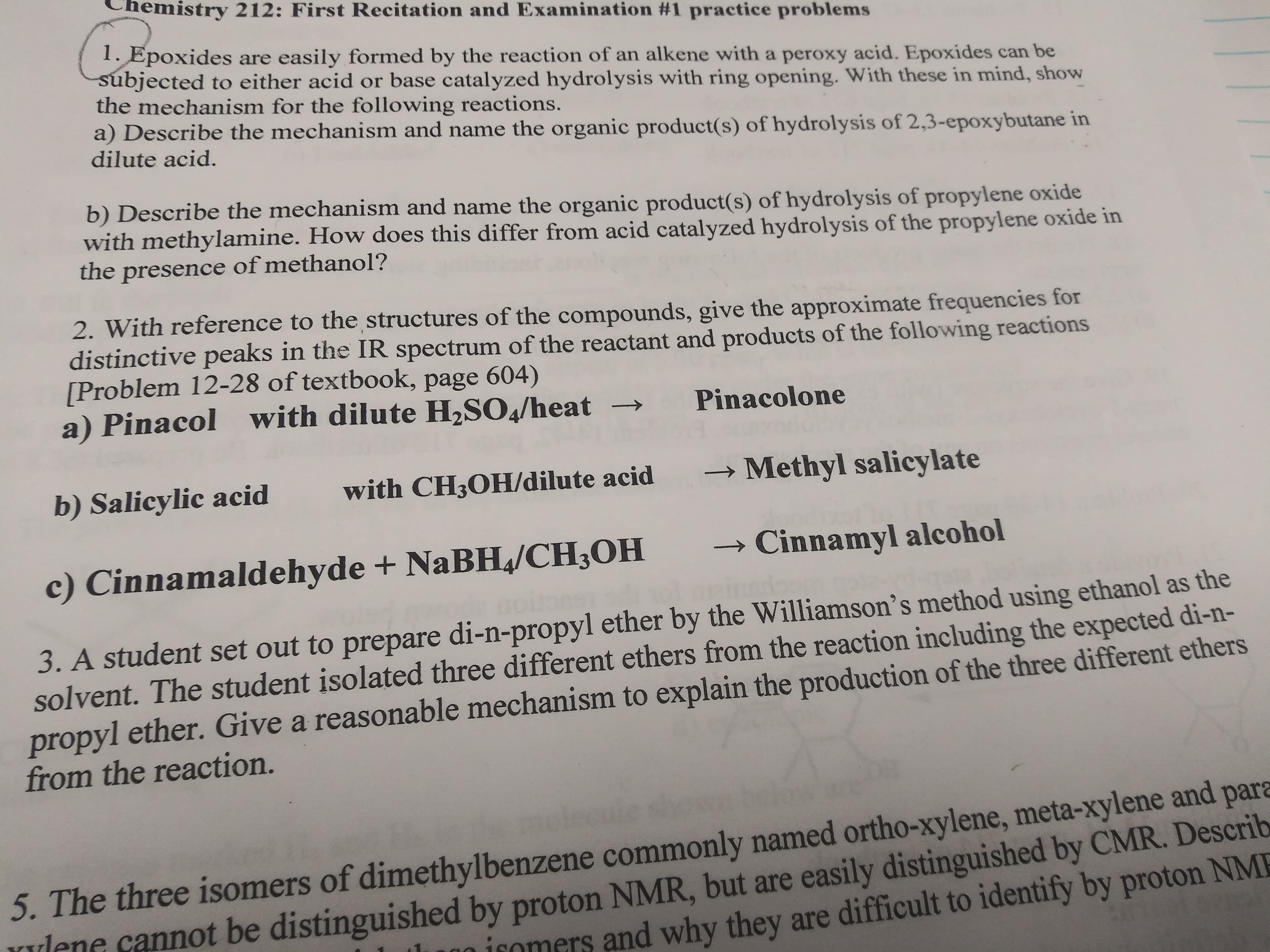mistry 212: First Recitation and Examination #1 practice problems 1. Epoxides are easily formed by the reaction of an alkene with a peroxy acid. Epoxides can be subjected to either acid or base catalyzed hydrolysis with ring opening. With these in mind, show the mechanism for the following reactions. a) Describe the mechanism and name the organic product(s) of hydrolysis of 2,3-epoxybutane in dilute acid. b) Describe the mechanism and name the organic product(s) of hydrolysis of propylene oxide with methylamine. How does this differ from acid catalyzed hydrolysis of the propylene oxide in the presence of methanol? 2. With reference to the structures of the compounds, give the approximate frequencies for distinctive peaks in the IR spectrum of the reactant and products of the following reactions [Problem 12-28 of textbook, page 604) a) Pinacol with dilute H2SO4/heat → Pinacolone b) Salicylic acid with CH3OH/dilute acid Methyl salicylate c) Cinnamaldehyde + NaBH/CH;OH Cinnamyl alcohol 3. A student set out to prepare di-n-propyl ether by the Williamson's method using ethanol as the solvent. The student isolated three different ethers from the reaction including the expected di-n- propyl ether. Give a reasonable mechanism to explain the production of the three different ethers from the reaction. low ace lecule ulene cannot be distinguished by proton NMR, but are easily distinguished by CMR. Describ isomers and why they are difficult to identify by proton NME 5. The three isomers of dimethylbenzene commonly named ortho-xylene, meta-xylene and para
mistry 212: First Recitation and Examination #1 practice problems 1. Epoxides are easily formed by the reaction of an alkene with a peroxy acid. Epoxides can be subjected to either acid or base catalyzed hydrolysis with ring opening. With these in mind, show the mechanism for the following reactions. a) Describe the mechanism and name the organic product(s) of hydrolysis of 2,3-epoxybutane in dilute acid. b) Describe the mechanism and name the organic product(s) of hydrolysis of propylene oxide with methylamine. How does this differ from acid catalyzed hydrolysis of the propylene oxide in the presence of methanol? 2. With reference to the structures of the compounds, give the approximate frequencies for distinctive peaks in the IR spectrum of the reactant and products of the following reactions [Problem 12-28 of textbook, page 604) a) Pinacol with dilute H2SO4/heat → Pinacolone b) Salicylic acid with CH3OH/dilute acid Methyl salicylate c) Cinnamaldehyde + NaBH/CH;OH Cinnamyl alcohol 3. A student set out to prepare di-n-propyl ether by the Williamson's method using ethanol as the solvent. The student isolated three different ethers from the reaction including the expected di-n- propyl ether. Give a reasonable mechanism to explain the production of the three different ethers from the reaction. low ace lecule ulene cannot be distinguished by proton NMR, but are easily distinguished by CMR. Describ isomers and why they are difficult to identify by proton NME 5. The three isomers of dimethylbenzene commonly named ortho-xylene, meta-xylene and para
Organic Chemistry
8th Edition
ISBN:9781305580350
Author:William H. Brown, Brent L. Iverson, Eric Anslyn, Christopher S. Foote
Publisher:William H. Brown, Brent L. Iverson, Eric Anslyn, Christopher S. Foote
Chapter21: Benzene And The Concept Of Aromaticity
Section: Chapter Questions
Problem 21.58P
Related questions
Question
Please answer question 1b

Transcribed Image Text:mistry 212: First Recitation and Examination #1 practice problems
1. Epoxides are easily formed by the reaction of an alkene with a peroxy acid. Epoxides can be
subjected to either acid or base catalyzed hydrolysis with ring opening. With these in mind, show
the mechanism for the following reactions.
a) Describe the mechanism and name the organic product(s) of hydrolysis of 2,3-epoxybutane in
dilute acid.
b) Describe the mechanism and name the organic product(s) of hydrolysis of propylene oxide
with methylamine. How does this differ from acid catalyzed hydrolysis of the propylene oxide in
the presence of methanol?
2. With reference to the structures of the compounds, give the approximate frequencies for
distinctive peaks in the IR spectrum of the reactant and products of the following reactions
[Problem 12-28 of textbook, page 604)
a) Pinacol with dilute H2SO4/heat →
Pinacolone
b) Salicylic acid
with CH3OH/dilute acid
Methyl salicylate
c) Cinnamaldehyde + NaBH/CH;OH
Cinnamyl alcohol
3. A student set out to prepare di-n-propyl ether by the Williamson's method using ethanol as the
solvent. The student isolated three different ethers from the reaction including the expected di-n-
propyl ether. Give a reasonable mechanism to explain the production of the three different ethers
from the reaction.
low ace
lecule
ulene cannot be distinguished by proton NMR, but are easily distinguished by CMR. Describ
isomers and why they are difficult to identify by proton NME
5. The three isomers of dimethylbenzene commonly named ortho-xylene, meta-xylene and para
Expert Solution
This question has been solved!
Explore an expertly crafted, step-by-step solution for a thorough understanding of key concepts.
This is a popular solution!
Trending now
This is a popular solution!
Step by step
Solved in 3 steps with 3 images

Knowledge Booster
Learn more about
Need a deep-dive on the concept behind this application? Look no further. Learn more about this topic, chemistry and related others by exploring similar questions and additional content below.Recommended textbooks for you

Organic Chemistry
Chemistry
ISBN:
9781305580350
Author:
William H. Brown, Brent L. Iverson, Eric Anslyn, Christopher S. Foote
Publisher:
Cengage Learning


Organic Chemistry
Chemistry
ISBN:
9781305580350
Author:
William H. Brown, Brent L. Iverson, Eric Anslyn, Christopher S. Foote
Publisher:
Cengage Learning
